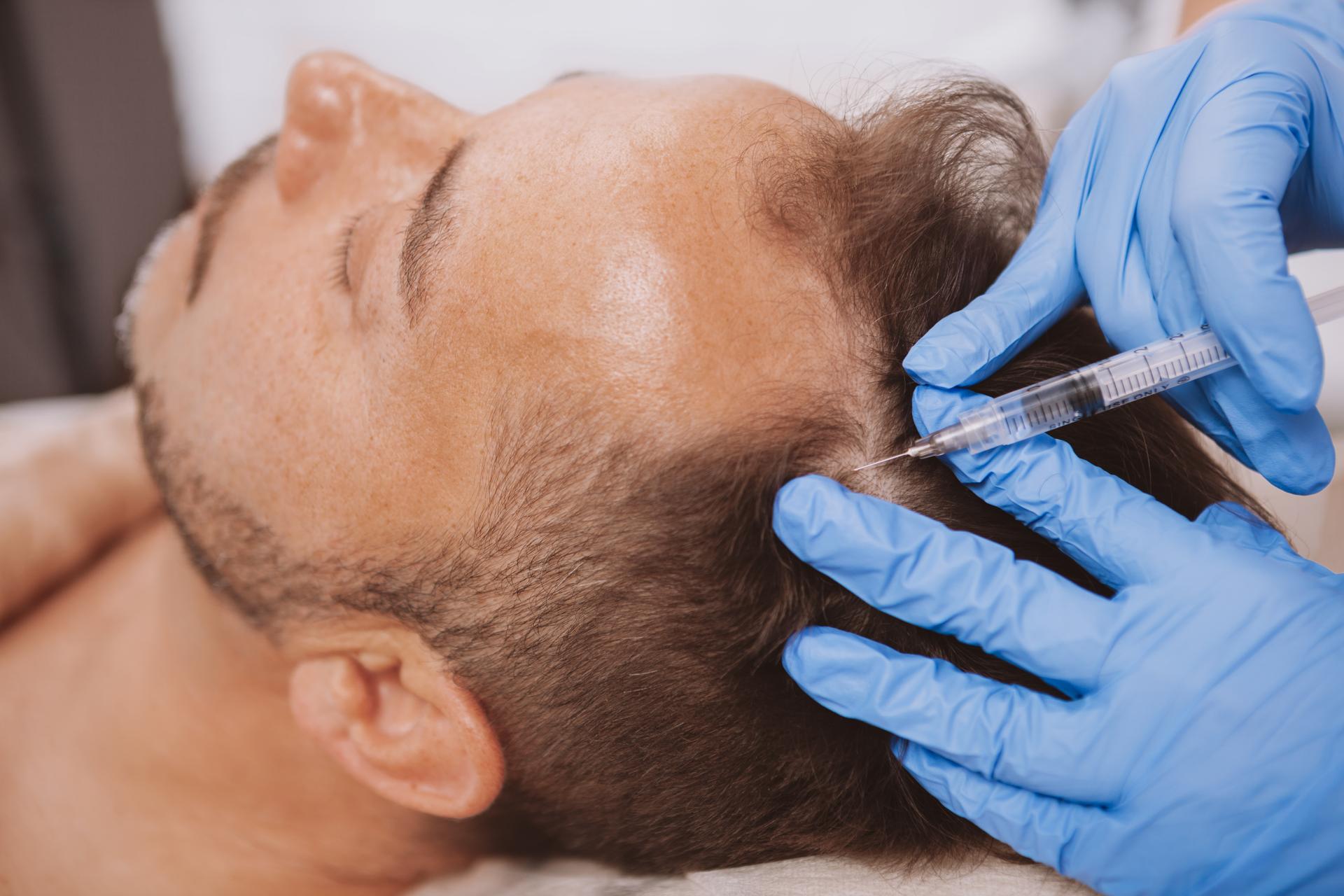Hair loss does not have a single explanation or a single solution, which is why deciding how to address it often involves considering several factors. The type of thinning you are experiencing, the rate at which it is progressing, and the degree of coverage you want all influence which approach may be best. For many patients, the question becomes whether non-surgical hair loss management is enough or if a transplant should be part of the plan.
Non-surgical options can give you meaningful results, but they are not always suited to every pattern or stage of loss. At New Jersey Hair Restoration Center, patients in Freehold Township and the surrounding areas can explore both non-surgical treatments and surgical transplants with a physician who knows how to pair the right option with the right patient.
The Causes and Science of Hair Loss
Hair loss often begins with the activity of dihydrotestosterone, or DHT, a byproduct of testosterone that binds to hair follicles. When DHT attaches to susceptible follicles, it causes them to shrink and produce thinner, weaker strands until the follicles eventually stop producing hair altogether. Genetics largely determines how sensitive your follicles are to DHT, which explains why male and female pattern baldness tends to follow family patterns.
Hormonal changes, chronic stress, nutritional deficiencies, and autoimmune conditions can also impact hair shedding. Thyroid disorders, iron deficiency, or sudden physiological stressors may interrupt the growth cycle and push follicles into a resting phase. Medications, scalp inflammation, and underlying medical conditions can further disrupt healthy growth.
Female vs. Male Pattern Baldness
Male pattern baldness usually begins with a receding hairline or thinning at the crown, eventually progressing in a recognizable pattern. Female hair loss, on the other hand, tends to present as diffuse thinning across the scalp without a clear pattern of recession. Hormonal fluctuations, especially around menopause, often influence female thinning, while men are more strongly influenced by DHT sensitivity. The distinction matters because treatment options vary depending on the underlying cause and the way the hair loss presents. A precise diagnosis helps determine whether non-surgical management, surgical restoration, or a combination of both is going to be the most effective strategy.
An Overview of Non-Surgical Hair Loss Management
Non-surgical hair restoration aims to slow progression and strengthen existing follicles rather than surgically moving hair. Medications can help reduce shedding and extend the growth cycle when used consistently under a doctor’s guidance, while regenerative treatments can help stimulate follicles and improve scalp health. Often, combining several of these treatments can help provide better results by covering a broader range of hair loss causes. Non-surgical methods may be most helpful in the early stages of hair loss when follicles are still healthy enough to be stimulated through regenerative methods.
Medical Therapies
Minoxidil
Minoxidil is one of the most widely recognized non-surgical hair loss options. This medication improves blood flow around the follicle, which supports the nutrient and oxygen supply needed for healthy growth. The topical solution or foam is applied directly to the scalp and must be used consistently to maintain results. Hair shedding can temporarily increase at the beginning of the treatment, as older hairs are pushed out so new growth can start.
Finasteride
Oral finasteride targets hair loss by blocking the conversion of testosterone into dihydrotestosterone, or DHT. Lowering DHT levels reduces the hormonal influence that causes follicles to shrink and eventually stop producing strong strands. Men benefit the most from this medication, and it is not often prescribed for women because of potential side effects. The medication must be taken consistently because stopping it usually allows DHT activity to resume.
Regenerative and Injectable Therapies
PRP
Platelet-rich plasma, or PRP, uses a concentration of your own blood platelets to stimulate follicle activity and improve scalp circulation. The process involves drawing a small amount of blood, spinning it in a centrifuge, and isolating the platelets before reintroducing them into targeted areas of thinning. Growth factors within the platelets can help extend the growth phase of hair and promote thicker strands.
PepFactor
PepFactor relies on a combination of peptides and basic fibroblast growth factors that work together to support scalp health and follicle stimulation. The treatment is injected into the scalp, followed by microneedling to stimulate the scalp further and promote deeper penetration of the ingredients. Increased collagen and blood flow create a healthier environment for follicles, which can lead to stronger and more resilient growth. These 30-minute sessions are usually scheduled every two weeks, and you can plan to have around six treatments.
Exosome Therapy
Exosome therapy for hair loss uses microscopic vesicles rich in growth factors and proteins to stimulate follicle activity and improve scalp health. We apply the solution to thinning areas and use microneedling to help the exosome solution be absorbed, which can encourage dormant follicles to produce thicker strands. Results usually begin to appear within two to three months, with greater improvement noticeable by about six months.
Laser Cap
Another option for thinning hair is the Laser Cap. This is a portable device that uses Low-Level Laser Therapy to improve follicle health and increase the volume of your hair. This device can be taken home and used every day to stimulate hair growth. It is non-invasive and painless and can be used anywhere, anytime.
What to Expect From Non-Surgical Results
Non-surgical hair restoration options can provide noticeable improvements, but the degree of change depends on the stage and pattern of hair loss. Most treatments focus on strengthening existing follicles, slowing shedding, and encouraging regrowth in areas where follicles remain active. Results develop gradually because the body requires time to respond to stimulation or medication. Consistency is important since stopping treatment usually allows thinning to progress again. A realistic plan involves understanding how non-surgical approaches work and the type of results you can expect.
Advantages and Disadvantages of Non-Surgical Options
Pros
Non-surgical treatments can slow progression and improve density without requiring surgery or downtime. Options like PRP, minoxidil, finasteride, and PepFactor are versatile and can be combined for a stronger effect. These approaches can help extend the life of existing follicles, which makes them valuable for patients who are not yet candidates for transplant. Flexibility is another benefit since adjustments can be made depending on how the scalp responds.
Cons
Non-surgical methods cannot replace follicles that have already been lost, which limits their effectiveness in advanced thinning. Consistency is necessary because results fade once treatment stops. Medications like finasteride may carry side effects, and topical solutions require daily use to remain effective. Regenerative therapies such as PRP and PepFactor often need multiple sessions and ongoing maintenance, which can become a long-term commitment. Realistic expectations are important because these treatments improve coverage but cannot fully restore density in areas where follicles are no longer active.
Surgical Hair Restoration Options
Follicular Unit Extraction (FUE)
FUE involves harvesting individual follicular units directly from the donor area, usually at the back or sides of the scalp. Each graft is then placed into thinning areas with careful attention to direction and density for a natural result. The absence of a linear scar makes this method appealing for patients who want shorter hairstyles. Recovery is generally quicker because the donor sites are small and heal without stitches. The procedure requires precision and time, but it provides flexibility in how grafts are distributed.
Follicular Unit Transplantation (FUT)
FUT differs from FUE because it removes a narrow strip of scalp tissue from the donor region, which is then dissected under a microscope into follicular units. This method often yields a large number of grafts in a single session, which can be useful for addressing extensive loss. A linear scar remains in the donor area, but it can usually be hidden beneath surrounding hair. Healing takes slightly longer compared to FUE since stitches are required to close the donor site. For patients who need maximum graft numbers in fewer sessions, FUT can be the right choice.
Comparing Non-Surgical vs. Surgical Approaches
Cost Considerations
Non-surgical treatments are more affordable at first because the expense is spread across multiple sessions or ongoing medication. The cumulative cost adds up with regular maintenance, especially when therapies must be continued indefinitely. Surgical hair restoration, such as FUE or FUT, carries a higher initial price, but the outcome is permanent since transplanted follicles continue to grow. We can help you weigh short-term affordability against long-term value.
Risks and Side Effects
Non-surgical options usually involve minimal downtime, but side effects like scalp irritation, shedding during the early stages of treatment, or medication-related issues can still occur. Finasteride may cause hormonal side effects in some men, and topical solutions sometimes trigger itching or dryness. Surgical approaches bring a different set of risks, including infection, scarring, and uneven growth if grafts do not heal properly. Both approaches require an honest discussion before starting treatment.
The Decision-Making Process for Hair Light Treatments
Step One: Diagnosis and a Consultation
Accurate diagnosis sets the foundation for any decision about hair restoration. A consultation allows us to evaluate your scalp’s health, follicle activity, and potential underlying causes such as hormonal shifts or nutritional deficiencies. Identifying the root problem makes it possible to select strategies that address both current thinning and the risk of future loss.
Step Two: Assess Your Degree of Hair Loss
The extent of thinning heavily influences which options are suitable. Early or moderate loss may respond well to medications, regenerative therapies, or devices that stimulate follicles. Advanced loss often requires surgical methods such as FUE or FUT to create meaningful coverage. Mapping the pattern of thinning helps clarify whether non-surgical management is sufficient or if transplantation is necessary.
Step Three: Considering Your Unique Factors
Personal factors shape the right path for hair loss treatment just as much as clinical findings. Goals differ between individuals who want subtle reinforcement versus those who want a dramatic restoration. Age, family history, and rate of thinning provide clues about how loss may progress, while tolerance for medications or repeated sessions affects the range of practical choices. Lifestyle and occupation also influence whether downtime from surgery is possible. When we factor all of these considerations into the decision, we can find the right solution for each patient.
Step Four: Assessing Cost and Willingness for Maintenance or Surgery
Cost is an unavoidable part of the decision-making process, and you need to weigh both immediate and long-term expenses. Some patients prefer gradual, lower-cost approaches, while others choose surgery for a more definitive outcome. A clear understanding of your budget and willingness to maintain treatments as needed can make the final decision more straightforward, and we will make the process easier by maintaining a transparent conversation throughout your treatment plan.
Let’s Find the Right Hair Restoration Option for You With a Consultation in Freehold Township, NJ
Surgical and non-surgical options for hair restoration each serve a purpose, and the best approach depends on the stage of thinning, the strength of donor follicles, and the outcome you want to achieve. A hair transplant can restore density where follicles are no longer active, while medical and regenerative therapies help preserve existing hair and slow future loss. To learn which treatment path is right for you, reach out to New Jersey Hair Restoration Center in Freehold Township, NJ at (732) 365-4533 or contact us through the online form.


